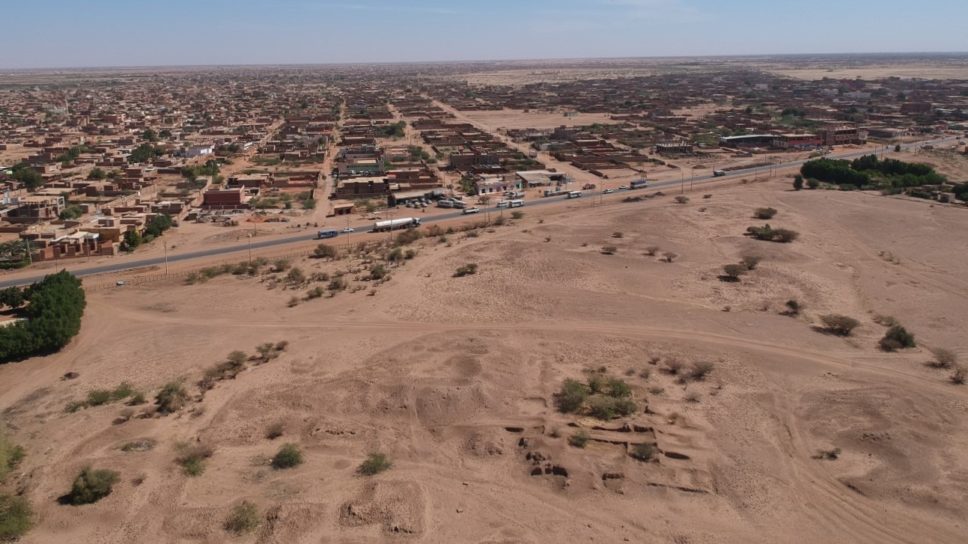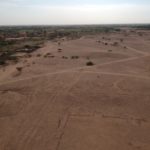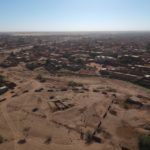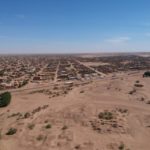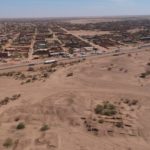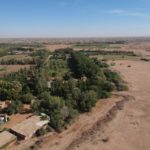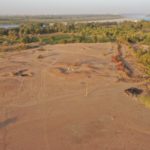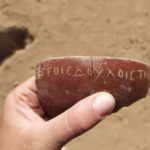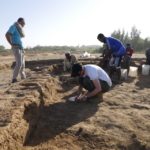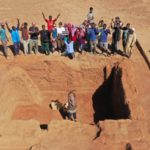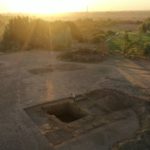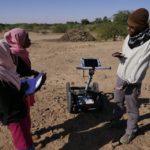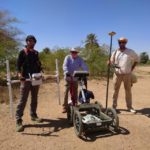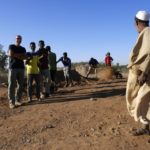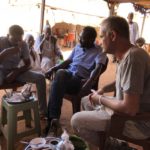Soba
Soba East
-
Project name:
Soba – the heart of the kingdom of Alwa. The spatial organization of medieval capital city on the Blue Nile
Project website:
Social media:
Facebook: Soba Expedition
Twitter: #SobaExpedition
Instagram: #SobaExpedition -
Type of site:
City, capital of the medieval kingdom of Alwa
Location:
Sudan
Khartoum Province
The Lower Blue Nile
Khartoum agglomeration, modern town of SobaDating:
Medieval period (5th–16th century)
Most interesting finds:
– two town districts of differenc character; one with dense architecture and clear street network, the other with loosely spaced large building compounds
History of research:
Dates of PCMA mission’s work:
2019–
Type of research:
Excavations, survey, geophysical research, ethnological research
Directors:
Mariusz Drzewiecki (2019– )
Co-operating institutions:
– Polish Centre of Mediterranean Archaeology, University of Warsaw
– Institute of Archaeology and Ethnology, Polish Academy of Sciences
– National Corporation for Antiquities and Museums, Sudan
– Department of Archaeology, Faculty of Arts, Al-Neelain University, Sudan
– University of Silesia in Katowice
– Historic Environment Scotland
Additional information:
The project is financed by the Polish National Science Centre’s grant no. UMO-2018/29/B/HS3/02533. It is being carried out in consortium with the Institute of Archaeology and Ethnology, Polish Academy of Sciences.
Description of the site and research:
Three kingdoms existed in medieval Nubia: Nobadia with the capital in Faras, Makuria with the capital in Dongola, and Alwa with the capital in Soba. These cities lay on the banks of the longest river in Africa. They were the heart of each kingdom, centers of power and religion. Kings and bishops resided there in impressive buildings. People came to the capitals from the farthest parts of the kingdoms. One could meet there merchants from far-away regions, travelers, emissaries, spies, as well as adventure-seekers and people looking to earn a decent income. Trade and local production of luxury goods flourished. Churches of various faiths were built in the cities, and on their outskirts monasteries were founded.
One of the medieval Arab travelers described Soba as a city with grand houses and large monasteries, richly-furnished churches and beautiful gardens. It was a multi-ethnic metropolis, the seat of royal and ecclesiastical power. Unfortunately, a lot of time has passed since then, and the city has fell into ruin. In the 19th century, abandoned and ruined buildings of Soba were dismantled, and the bricks were used to build the new capital – Khartoum. In the 20th century, a few archaeologists explored this area, uncovering traces of monumental buildings. They also found extremely interesting, unconventional objects, e.g., a funerary stele of a previously-unknown king David, and objects which reached Soba from the cities of the Mediterranean Basin and the Far East. It is estimated that in its heyday, Soba covered approximately 275 ha. Only 1% of its area has been investigated to date.
The PCMA project aims to study the medieval architecture of Soba. We want to find out where each city quarter was located and how they were organized. We will look for the royal palace and the houses of both rich and poor inhabitants. We will try to determine the location of production areas, including pottery and metal workshops which manufactured objects of everyday use as well as luxury goods. We will also study the old road network and open spaces, such as squares and cemeteries.
Today, most of the ancient capital is covered by modern houses and arable land. The central part of Soba is a protected area, but no traces of ancient buildings can be seen there. The medieval architecture is hidden just below the surface, and only fragments of objects which had once served the inhabitants of the city can be found on the ground.
To reach our goals, we will apply the latest research methods used in archaeology, ethnology and geophysics. Archaeologists will look for objects connected with the past inhabitants of the city. Geophysical research will record magnetic anomalies, which can reflect the presence of ancient walls and buildings. It may be thus possible to reconstruct, based on the map of these anomalies, the layout of streets, houses, public buildings and entire quarters of Soba. An ethnologist will visit modern inhabitants and ask them about the surrounding monuments as well as the stories and legends concerning the ancient metropolis. It may be that they have found traces of the past or historical objects in the vicinity of their houses or on their land. All information will be combined and compared, which will allow us to map out the layout of Soba.
The team will consist of researchers from several Polish scientific institutions who specialize in pottery, glass, organic and metal finds (if such objects will appear). They will be joined by specialists in archaeological geophysics, ethnology, architecture and art of medieval Nubia.
January 2024 – “About Soba and archaeology” – meetings in schools
February 2023 – Soba 2023: Workshops, lessons and ethnographic research
August 2022 – Open-air exhibition in Warsaw: From Faras to Soba
August 2022 – “From Faras to Soba” – new book in Open Access
December 2021 – Medieval gardens and full storerooms in Soba (Sudan)
May 2021 – Polish Society of African Studies award for Mariusz Drzewiecki’s book
April 2021 – PCMA scholar’s seminar: Population diversity in Soba
February 2020 – Soba: results of the first research season
November 2019 – Soba: a new research project in Sudan
Project bibliography:
Drzewiecki, M., Ryndziewicz, R., Michalik, T., Ciesielska, J., Czyżewska-Zalewska, E., Ryś, A., Bebel-Nowak, A., Kurcz, M., Rączkowski, W., & Żuk, L. (2022). Soba Expedition: The preliminary report on the season of fieldwork conducted in 2021-2022. Studia Etnologiczne i Antropologiczne, 1-59. https://doi.org/10.31261/SEIA.2022.22.01.01
Drzewiecki, M., Ryndziewicz, R., Ciesielska, J., Kurcz, M., Michalik, T., & Czyżewska-Zalewska, E. (2021). The spatial organisation of Soba: A medieval capital on the Blue Nile. Antiquity, 1–8. doi:10.15184/aqy.2021.158
Drzewiecki, M., Kurcz, M., Ciesielska, J. Michalik T., Czyżewska-Zalewska E., Kiersnowski, K., Ryndziewicz R. (2021). Interdisciplinary Research into the Legacy of the Medieval Metropolis of Soba in a Modern Khartoum Suburb. African Archaeology Revue. https://doi.org/10.1007/s10437-021-09459-1
Ryndziewicz, R., Drzewiecki, M., Banaszek, Ł., Herbich, T., Kiersnowski, K., (2021). Survey of Soba (Sudan), ArcheoSciences, 45-1, 111–114, https://doi.org/10.4000/archeosciences.8880
Drzewiecki, M., Ryndziewicz, R., Ciesielska J.A., Michalik, T., Kurcz M., Czyżewska-Zalewska E., Adam, R. J., (2020). New fieldwork at Soba East (2019–2020 season), Sudan & Nubia 24, 233–246.
Drzewiecki M., Ryndziewicz R., Michalik T., Ciesielska J., Czyżewska-Zalewska E., Kurcz M., Hassan M.M.A.M. (2020). Soba Expedition. Preliminary report on the season of fieldwork conducted in 2019-2020. Khartoum (doi.org/10.6084/m9.figshare.12023022.v2).
Drzewiecki M., Michalik T., Ciesielska J. (2020). Soba Expedition. Preliminary report on the archaeological excavation before the construction of the storage house. Khartoum (doi.org/10.6084/m9.figshare.11981328.v3).
Drzewiecki M., Ryndziewicz R. (2019). Developing a New Approach to Research at Soba, the Capital of the Medieval Kingdom of Alwa. Archaeologies: Journal of the World Archaeological Congress 16, 1–24.
Select site bibliography:
Welsby, D.A. (2004). Soba East. In D.A. Welsby, J.R. Anderson (eds), Sudan Ancient Treasures: an exhibition of recent discoveries from the Sudan National Museum (pp. 197–237). London.
Abdel Rahman Ali Mohamed (2000). Rescue Excavations at Soba East. Sudan and Nubia, 4, 27–31.
Welsby, D.A. (1998). Soba II. Renewed excavations within the metropolis of the Kingdom of Alwa in Central Sudan (=Memoirs of the British Institute in Eastern Africa 15). London.
Welsby, D.A. (1996). The Medieval Kingdom of Alwa. In R. Gundlach, M. Kropp, A. Leibundgut (eds), Der Sudan in Vergangenheit und Gegenwart (pp. 179–194). Frankfurt-am-Main.
Kirwan, L.P. (1994). Christianity in the Central Sudan. The Byzantine Mission and Nubian Alwa. In C. Berger, G. Clarc, N. Grimal (eds), Hommages à Jean Leclant (Bet 106), vol. 2 (pp. 245–249). Cairo.
Welsby, D.A., Sjöström, I.Y. (1994). Excavations at Soba East, Central Sudan, 1990–91. Archéologie du Nil Moyen, 6, 177–186.
Welsby, D.A. (1992). Windows in Medieval Nubia: The Evidence from Soba East. Antiquaries Journal, 72, 174–178.
Mohi el-Din Abdalla Zarroug (1991). The Kingdom of Alwa (=African Occasional Papers 5). Calgary.
Welsby, D.A. (1991). Early Medieval and Pre-Medieval Soba. In W.V. Davies (ed.), Egypt and Africa (pp. 278–285). London.
Welsby, D.A., Daniels, C.M. (1991). Soba. Archaeological Research at a Medieval Capital on the Blue Nile (=Memoirs of the British Institute in Eastern Africa 12). London.
Welsby, D.A. (1990). Pottery Production and Supply at Soba East. In W. Godlewski (ed.), Coptic and Nubian Pottery (pp. 10–17). Warsaw.
Kirwan, L.P. (1989). Meroe, Soba and the Kingdom of Alwa. In S. Donadoni, S. Wenig (eds), Studia Meroitica 1984: Proceedings of the Fifth International Conference for Meroitic Studies, Rome 1984 (=Meroitica 10) (pp. 299–304). Berlin.
Welsby, D.A. (1987). A Perspective of Nubia from Soba. In T. Hägg (ed.), Nubian Cultures: Past and Present. Main Papers Presented at the Sixth International Conference for Nubian Studies in Uppsala, 11–16 August, 1986 (=Konferenser 17) (pp. 279–284). Stockholm.
Kirwan, L.P. (1986). The Rise of Soba as the Capital of Alwa. In R. Dehlin, T. Hägg (eds), Abstracts of Communications: Sixth International Conference for Nubian Studies (pp. 72–73). Bergen.
Lejean, G. (1965). Voyage aux deux Nils (Nubie, Kordofan, Soudan Oriental) . Paris.
Shinnie, P.L. (1961). Excavations at Soba (=Sudan Antiquity Service Occasional Papers 3). Khartoum.
Monneret de Villard, U. (1935). La Nubia medioevale, 2 vols. Le Caire.
Hillelson, S. (1933). David Reubeni, an Early Visitor to Sennar. Sudan Notes and Records, 16/1, 55–66.
Budge, E.A.W. (1907). The Egyptian Sudan, 2 vols. London.
Ward, J. (1905). Our Sudan, Its Pyramids and Progress. London.
Dümichen, J. (1894). Zur Geographie des Alten Ägypten. Leipzig.
Gallery:
-
The central part of the earstwhile city is now a protected heritage area, but its remaining parts have been covered by buildings or turned into farmland / Centralna cześć dawnego miasta jest obecnie obszarem chronionym, pozostałe tereny są zabudowane lub zostały przekształcone w pola uprawne (fot. M. Drzewiecki)
-
The western part of the site with remains of medieval mud-brick structures, and modern buildings in the background / Zachodnia część stanowiska, na pierwszym planie pozostałości średniowiecznych budynków z cegły mułowej, na dalszym planie współczesna zabudowa (fot. M. Rageb Nolwata Islind)
-
The north-western part of the site was cut by an asphalt road in the 1990s; in the foreground – ruins of medieval Soba / Płn.-zach. część stanowiska została przecięta przez drogę asfaltową w latach 90. XX wieku; na pierwszym planie ruiny średniowiecznej zabudowy Soba (fot. M. Rageb Nolwata Islind)
-
Medieval remains against the backdrop of the modern town / Na pierwszym planie pozostałości średniowiecznej zabudowy, w tle współczesne miasto sudańskie (fot. M. Abdelfatah Fadalalseed)
-
Orchards and fields cover large parts of the archaeological site / Sady i pola uprawne pokrywają znaczą część stanowiska (fot. M. Drzewiecki)
-
View of the research area / Widok terenu badań (fot. M. Drzewiecki)
-
Potsherd with Greek inscription / Fragment naczynia ceramicznego z tekstem zapisanym w języku greckim (fot. J. Ciesielska)
-
Excavation work at Soba / Prace wykopaliskowe w Soba (fot. J. Ciesielska)
-
The Soba team, December 2019 / Zespół wykopalisk w Soba, grudzień 2019 (fot. M. Drzewiecki)
-
In area OS the mission uncovered a fragment of a well preserved mud-brick complex / W wykopie na komie OS odsłonięto fragment dobrze zachowanego kompleksu budynków z cegły mułowej (fot. M. Drzewiecki)
-
Robert explaining the science behind the Ground Penetrating Radar to students / Robert wyjaśniający studentom działanie georadaru / (fot. M. Drzewiecki)
-
The Soba geophysical team, from left: Robert with magnetometer, Tomasz with GPR and Krzysztof with GPS RTK / Geofizycy z IAE PAN, od lewej: Robert z magnetometrem, Tomasz z georadarem oraz Krzysztof z GPSem RTK (fot. M. Drzewiecki)
-
Al-Geili the gafir of Soba is also the chief of workers / Al-Dżeili, strażnik stanowiska (na pierwszym planie), zaganiał wszystkich do pracy (fot. T. Michalik)
-
Maciej during an interview, asking about the understanding of Soba’s past and history / Maciej w czasie rozmowy na tematy związane z przeszłością i historią Soba (fot. J. Ciesielska)
-
Presenting drawings made by Polish kids to primary school kids at Soba / Prezentacja rysunków polskich dzieci w szkole w Soba (fot. J. Ciesielska)

